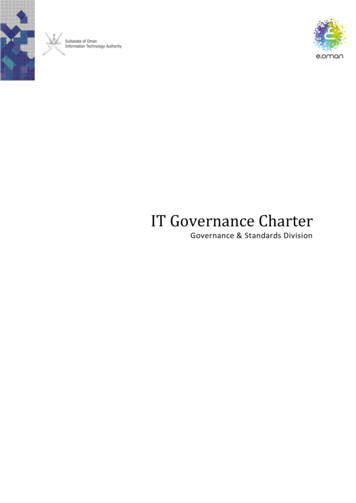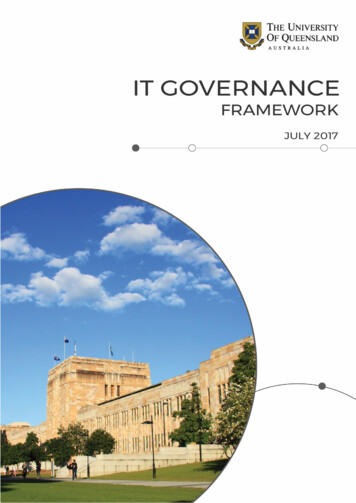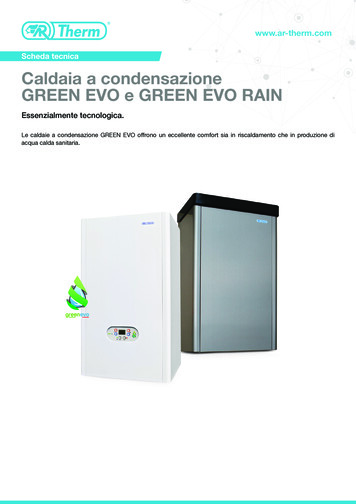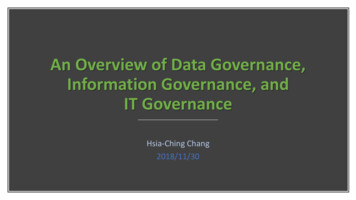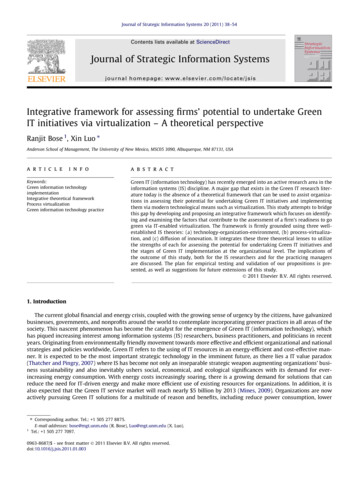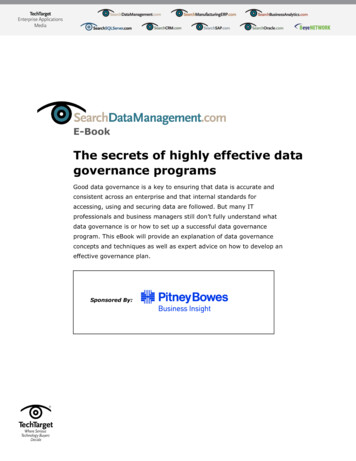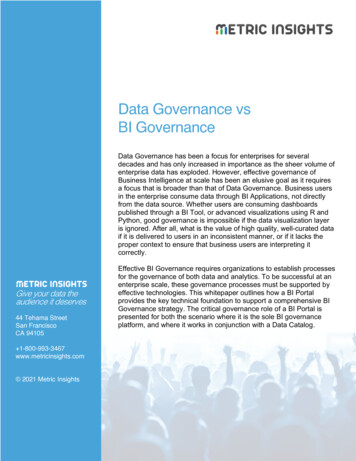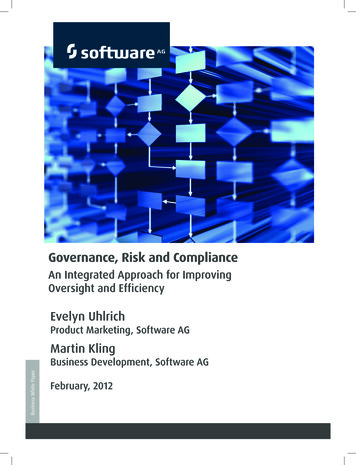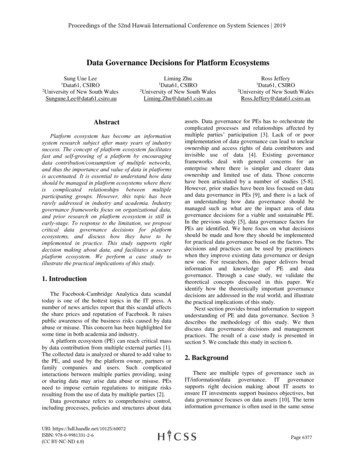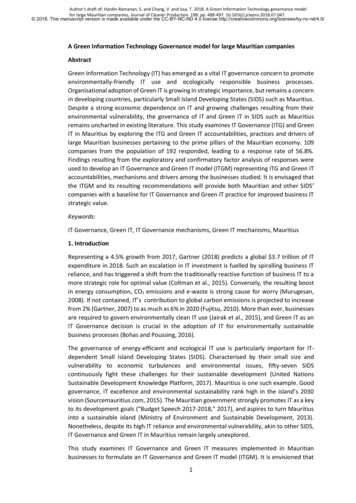
Transcription
Author's draft of: Hardin-Ramanan, S. and Chang, V. and Issa, T. 2018. A Green Information Technology governance modelfor large Mauritian companies. Journal of Cleaner Production. 198: pp. 488-497. 10.1016/j.jclepro.2018.07.047. 2018. This manuscript version is made available under the CC-BY-NC-ND 4.0 license http://creativecommons.org/licenses/by-nc-nd/4.0/A Green Information Technology Governance model for large Mauritian companiesAbstractGreen Information Technology (IT) has emerged as a vital IT governance concern to promoteenvironmentally-friendly IT use and ecologically responsible business processes.Organisational adoption of Green IT is growing in strategic importance, but remains a concernin developing countries, particularly Small Island Developing States (SIDS) such as Mauritius.Despite a strong economic dependence on IT and growing challenges resulting from theirenvironmental vulnerability, the governance of IT and Green IT in SIDS such as Mauritiusremains uncharted in existing literature. This study examines IT Governance (ITG) and GreenIT in Mauritius by exploring the ITG and Green IT accountabilities, practices and drivers oflarge Mauritian businesses pertaining to the prime pillars of the Mauritian economy. 109companies from the population of 192 responded, leading to a response rate of 56.8%.Findings resulting from the exploratory and confirmatory factor analysis of responses wereused to develop an IT Governance and Green IT model (ITGM) representing ITG and Green ITaccountabilities, mechanisms and drivers among the businesses studied. It is envisaged thatthe ITGM and its resulting recommendations will provide both Mauritian and other SIDS’companies with a baseline for IT Governance and Green IT practice for improved business ITstrategic value.Keywords:IT Governance, Green IT, IT Governance mechanisms, Green IT mechanisms, Mauritius1. IntroductionRepresenting a 4.5% growth from 2017, Gartner (2018) predicts a global 3.7 trillion of ITexpenditure in 2018. Such an escalation in IT investment is fuelled by spiralling business ITreliance, and has triggered a shift from the traditionally reactive function of business IT to amore strategic role for optimal value (Coltman et al., 2015). Conversely, the resulting boostin energy consumption, CO2 emissions and e-waste is strong cause for worry (Murugesan,2008). If not contained, IT’s contribution to global carbon emissions is projected to increasefrom 2% (Gartner, 2007) to as much as 6% in 2020 (Fujitsu, 2010). More than ever, businessesare required to govern environmentally clean IT use (Jairak et al., 2015), and Green IT as anIT Governance decision is crucial in the adoption of IT for environmentally sustainablebusiness processes (Bohas and Poussing, 2016).The governance of energy-efficient and ecological IT use is particularly important for ITdependent Small Island Developing States (SIDS). Characterised by their small size andvulnerability to economic turbulences and environmental issues, fifty-seven SIDScontinuously fight these challenges for their sustainable development (United NationsSustainable Development Knowledge Platform, 2017). Mauritius is one such example. Goodgovernance, IT excellence and environmental sustainability rank high in the island’s 2030vision (Sourcemauritius.com, 2015). The Mauritian government strongly promotes IT as a keyto its development goals (“Budget Speech 2017-2018,” 2017), and aspires to turn Mauritiusinto a sustainable island (Ministry of Environment and Sustainable Development, 2013).Nonetheless, despite its high IT reliance and environmental vulnerability, akin to other SIDS,IT Governance and Green IT in Mauritius remain largely unexplored.This study examines IT Governance and Green IT measures implemented in Mauritianbusinesses to formulate an IT Governance and Green IT model (ITGM). It is envisioned that1
2018. This manuscript version is made available under the CC-BY-NC-ND 4.0 license he ITGM will assist Mauritian companies, and subsequently similar SIDS, in maximising boththeir IT business value and sustainability quotient. The remaining sections of this paper arestructured as follows. Section 2 presents a review of existing IT Governance and Green ITliterature. The section also justifies the rationale for IT Governance and Green IT research inthe Mauritian context. Section 3 describes the conceptual IT Governance and Green IT modelunderlying the study. Section 4 details the research design. This is followed by section 5 whichdiscusses the ITGM findings and provides further recommendations. Section 6 concludes thepaper.2. Theoretical Background2.1. IT Governance and Green ITCoined in the late 1990s, the term IT Governance stems from earlier research on business/ITimpact, alignment and investment (De Haes et al., 2013). Since then, effective IT Governancehas transcenced IT decision accountabilities alone to also include a set of mechanisms thatenhance business/IT synergy for the achievement of business goals (Weill, 2004).Increasingly, ITG underlies corporate governance considerations essential for IT to align withbusiness exigencies (Rubino and Vitolla, 2014) such as growing stakeholder pressure forenvironmental sustainability (den Uyl and Driessen, 2015). Green IT considerationsemanating from top level management (Akman and Mishra, 2015) and rooted in ITgovernance practices are thus essential for organisations to benefit from the power of IT toenhance clean production.Several definitions of Green IT have emerged in literature with most of them considering ITenvironmental sustainability across the IT lifecycle. For example, Molla, Cooper andPittayachawan (2011, p. 73) define Green IT as the “systematic application of ecologicalsustainability criteria (such as pollution prevention, product stewardship, use of cleantechnologies) to the creation, sourcing, use and disposal of the IT technical infrastructure aswell as within the IT human and managerial practices.” This definition also reinforces theimportance of Green IT decisions in the governance of IT (ITGI, 2011), as it encompasseshuman and managerial practices which include Green IT beliefs, strategies and policiesessential for the governance of environmentally sustainable IT.Given the growing strategic importance of Green IT (Akman and Mishra, 2015), the past twodecades have seen increasing research on both IT’s own carbon footprint and its power tosupport ecological business processes (El Idrissi and Corbett, 2016). Deep concerns have beenraised about the increasing energy demands for powering and cooling of business datacentres, their subsequent costs and rising carbon emissions (Uddin and Rahman, 2012), aswell as the growing problem of e-waste (Molla and Abareshi, 2012). Paradoxically, when usedjudiciously, IT can turn into a powerful business ally for environmental sustainability (Chen,Boudreau and Watson 2008). Businesses across the world appear to have understood this asthey invest more in energy-efficient IT devices and IT solutions (GeSI 2015). As predicted inthe #SMARTer2030 ICT Solutions for the 21st Century Challenges report, such rise in GreenIT investment will result in a 20% global carbon emission reduction and a decrease of ITreleased carbon to 1.97% by 2030 (GeSI 2015). Green IT investments also carry severalbusiness benefits such reduced costs (Cai et al., 2013) and increased environmental firmperformance (Xia et al., 2014) which result in greater business competitiveness,Yet, despite realising the importance of IT Governance and Green IT to optimise business ITvalue and sustainability (Hanne 2011), Green IT remains a concern in developing countries,2
2018. This manuscript version is made available under the CC-BY-NC-ND 4.0 license specially due to their perceived lack of Green IT awareness (Chugh et al., 2016) and lowGreen IT maturity levels as compared to their developed counterparts (Wabwoba et al.,2013). SIDS with high IT dependency and extreme vulnerability to the dangers of climatechange, such as Mauritius, are no different.2.2. IT Governance and Green IT in MauritiusFrom its economic blue-print for the achievement of high income status by 2025 (Kalumiyaand Kannan, 2015) to its 2017-2018 budget announcements (“Budget Speech 2017-2018,”2017), the Mauritian government strives to turn Mauritius into a prominent IT hub and adigital economy. Environmental sustainability also runs high on the island’s agenda. TheWorld Bank (2015) ranks Mauritius in its list of top ten countries with high exposure to naturaldisasters, and the island occupies the 13th position on the 2017 WorldRiskIndex forenvironmental vulnerabilities (“World Risk Report Analysis and Prospects,” 2017). Mauritiusis also not proud of its carbon emissions which rose by 3.8% in 2015 (Statistics Mauritius,2015). Such environmental issues resulted in the Mauritian government’s “Maurice IleDurable” (MID) project for environmentally sustainable behaviours (The Ministry ofEnvironment and Sustainable Development, 2011). Ecological concerns are also noted in theisland’s 2030 vision in which it pledges a 30% reduction in Greenhouse Gas (GHG) emissions,and Intended Nationally Determined Contributions (INDCs) submitted to the United NationsFramework Convention on Climate Change (UNFCC) for the 2015 Paris Climate Conference(Government of Mauritius, 2015). Realising the importance of IT in this quest forsustainability, the Ministry of Information and Communication Technology (2013) came upwith a national Green ICT policy, but this has been withheld since the change in governmentin 2015. An IT Governance and Green IT model is therefore essential to better guideMauritian organisations in optimising IT potential for business value and sustainability. Thisis discussed next.3. Conceptual research modelThe first step in developing the conceptual ITGM was to recognise key IT Governance andGreen IT constructs from literature. Two main dimensions of ITG were thus identified: (1) ITdecisions and their accountability archetypes (Weill, 2004), and (2) ITG mechanisms (De Haesand Van Grembergen, 2009). These were followed by Molla et al.’s (2011) five essentialmechanisms for organisational Green IT readiness. All constructs are summarised andexplained in Table 1.3
2018. This manuscript version is made available under the CC-BY-NC-ND 4.0 license able 1: Summary of key IT Governance and Green IT constructsIT Decisions Weill(2004)IT principlesProvide guidelines for organisational IT useIT architectureRefer to policies governing technical IT choicesIT infrastructureDetermine hardware/software and IT human resourcerequirementsBusiness application needsJustify the choice of either off-the-shelf or tailor-madeIT solutionsIT investment and prioritisation Determine the selection of IT projects and their costIT Decision Accountabilities referred to as IT Governance Archetypes (Weill 2004)Business monarchyBusiness executives are accountable (may also includeIT executives).IT monarchyOnly IT executives are accountable.FeudalIndividual business units or functions take their own ITdecisions.FederalBusiness executives, Business Unit (BU) leaders, andsometimes, IT executives collaboratively take the ITdecision.IT duopolyIT executives together with either business executivesor BU leaders hold the IT the decision accountabilityAnarchyIndividual users take their own IT decisionIT Governance Mechanisms (De Haes and Van Grembergen 2009)StructuresFormal executive positions or IT committees whichconnect IT and business in strategic IT decision-makingProcessesMethodologies that assist IT decision-taking andmonitoringRelational mechanismsActive involvement and collaboration amongexecutives, IT and business management for therealisation of IT and business goalsGreen IT Mechanisms (Molla et al. 2011)Green IT attitudeEcological beliefs of business and IT leadersGreen IT policyFormal guidance for the successful implementation ofGreen ITGreen IT practiceFor environmentally sustainable considerations in thepurchase, use and disposal of ITGreen IT technologyInformation technology that promotes energyefficiency and carbon emission reductionGreen IT governanceFor Green IT decision accountability, budgeting,monitoring and reportingGiven the importance of ITG in efficient and clean IT use, the initial ITGM shown in Figure 1was developed by merging ITG decisions and accountabilities (archetypes) with the ITGmechanisms and the first four Green IT constructs described in Figure 1. Green IT was addedto the model as an additional IT decision to complement those identified by Weill (2004),since it was found to be increasingly considered in strategic IT. ITG and Green IT mechanismssupport ITG decision accountabilities. The fifth G-Readiness construct, Green IT governance(Molla and Cooper, 2009), is not included as a Green IT mechanism since it is a part of theother two sections of the model (IT decision accountabilities and governance mechanisms).4
2018. This manuscript version is made available under the CC-BY-NC-ND 4.0 license T DECISION ACCOUNTABILITIESIT decision typesIT GOVERNANCEMECHANISMS StructuresProcessesRelationalmechanismsIT principlesIT architectureIT infrastructureBusiness ApplicationNeedsIT investment &prioritisationGreen ITAccountabilities GREEN ITMECHANISMS AttitudePolicyPracticeTechnologyBusiness monarchyIT monarchyFeudalIT duopolyFederalAnarchyFigure 1: Conceptual IT Governance and Green IT model (Adapted from Weill (2004), DeHaes and Van Grembergen (2009), Molla and Cooper (2009))4. Research designData collection consisted of a survey of large companies belonging to the five main pillars ofthe Mauritian economy namely, namely: finance, tourism, ICT, textile and sugar industries(The World Bank, 2015). Large companies were targeted due to their greater inclination forIT Governance (Debreceny, 2013), and keener interest in Green IT endeavours triggered bytheir high energy consumption, resource availability and technical expertise (Molla andAbareshi, 2011). Aligning with the Mauritian Small and Medium Enterprises DevelopmentAuthority (SMEDA) Act 2009, large organisations were defined as companies generating anannual turnover exceeding 50 million rupees. The Mauritian private sector was alsoprioritised owing to its dominance in the island’s economy.The survey questionnaire was developed using relevant literature for content validity. Apartfrom eliciting demographical information, the questionnaire was structured into thefollowing four sections: IT decision accountabilities, IT Governance mechanisms, Green ITmechanisms, and IT Governance and Green IT influencers. The survey was administered toboth executives (CxOs) and IT managers from the company population identified. This isbecause IT Governance is not only the prime responsibility of executives, but it also needs tobe understood and implemented by IT managers (Willson and Pollard, 2009).The population of large organisations from the five main pillars of the Mauritian economy isshown in Table 2, and was first identified using the 2007 database of companies availablefrom the Central Statistical Office (CSO) of Mauritius, now known as Statistics Mauritius.Since this was the only database available at the time of the research, the sampling framewas further refined by calling the companies involved and checking their websites to discoverclosures and mergers. The population of eligible companies was also updated by consultingcompany directories such as the 2012 directory of IT companies. Questionnaires were sent5
2018. This manuscript version is made available under the CC-BY-NC-ND 4.0 license o all the companies in the sampling frame due to the 35% - 40% acceptable response rate ofexecutives and high-level managers reported by Baruch and Holtom (2008). As can be seenfrom Table 2, 109 out of the 192 companies identified participated in the research, and atotal of 128 questionnaires were compiled out of which 121 were valid (seven questionnaireswere incomplete and therefore rejected). The company response rate was therefore 56.8%and above the acceptable upper range of 40% advocated by Baruch and Holtom (2008).63.9% of non-participants provided reasons. These ranged from being too busy (38%), to alack of interest in the research (18%) to confidentiality issues (7.9%). Survey demographicsdata also identified 58.7% of respondents as being IT managers, 21.5% as business executivesand 19.8% as IT executives. 91.8% of companies belonged to the private sector as comparedto 3.3% from the public sector and 5% from the parastatal group. This was expected due tothe private sector dominance in key Mauritian economic sectors.Table 2: Details of survey eITTourismTOTAL504437520192Number ofparticipatingcompanies132324913109Number of questionnairesTotal receivedTotal valid133386113128133355812121Survey data was then analysed using Principal Component Analysis (PCA) followed byConfirmatory Factor Analysis (CFA). SPSS 21.0 and Lisrel 8.80 were used to run the PCA andCFA respectively. CFA was effected using polychoric correlations with weighted least squares(WLS). Due to the small sample size, a parallel model with all latent variable items constrainedto be equal, was preferred for improved model accuracy (Molla, Cooper and Pittayachawan2011). Model fit was indicated by a non-significant (p 0.05) and small chi-square (χ2) valuerelative to its degrees of freedom (df) (Dyer et al., 2005) coupled with the following goodnessof fit index range: Root Mean Square Error Of Approximation (RMSEA) 0.06; StandardisedRoot Mean Residual (SRMR) 0.08 (Hu and Bentler 1998); Comparative Fit Index (CFI) 0.9;Non-Normed Fit Index (NNFI) 0.9 (Hu and Bentler 1999); Parsimonious Fit Index (PNFI) 0.5 (Mulaik et al., 1989). In case of model unfit, variables with modification index (MI) above5 (Gefen, 2003) and standardised residuals exceeding 2.58 (Segars and Grover 1993) wereremoved. Unidimensional validity or affirmation that an item relates to only one factor, wasbased on MI values less than 5 to indicate the absence of cross-loadings (Gefen, 2003).Convergent validity or the extent to which factor items are related to each other, wasdemonstrated by statistically insignificant (p 0.05) χ2 and factor loadings (λ) 0.707 (Straub,Boudreau and Gefen 2004). Where a mechanism or influencer had more than one factor,discriminant validity and factorial validity had to be determined. Discriminant validity orconfirmation that factors were unrelated to each other was ascertained using a χ2 test ofdifference on factor pairs to demonstrate a statistically significant lower value for theunconstrained model (correlation between factors set free) as opposed to the constrainedone (correlation between factors set to 1) (Anderson and Gerbing, 1988). Factorial validitywas indicated by valid goodness-of-fit indices (Straub et al., 2004).5 Results5.1 IT Decision Accountabilities6
2018. This manuscript version is made available under the CC-BY-NC-ND 4.0 license able 3 shows a summary of IT accountability survey responses across IT decision typesidentified in Figure 1. Since IT duopolies comprise of joint decision accountability between ITexecutives and either BU or business executives (Weill 2004), each accountability pair (IT &BU leaders; IT & business executives) was treated as a separate column in Table 3. Businessmonarchies may or may not include IT executives (Weill 2004), hence the differentiationbetween the two in Table 3. Weill (2004) also states that the collaborative IT decisionaccountability of business and IT executives can either take the form of a business monarchywhere the IT executive sits on the board of directors and shares responsibility with otherboard members for the IT decision, or an IT duopoly where the IT executive teams up withbusiness executives for IT decision accountability. Both these archetypes were groupedunder one column as they involve joint accountability of business and IT executives. Thefederal IT decision archetype may or may not include IT heads (Weill 2004); hence the twocolumns for the federal accountability mode. None of the survey responses attributed ITdecision responsibility to individual users, thus explaining the absence of the anarchyarchetype in Table 3.IT accountability archetype preferences were then deduced based on highest frequencies(shown in red). The IT monarchy archetype was clearly the most popular mode of IT decisionaccountability. IT executives or heads thus appear to be primarily answerable for IT andGreen IT decisions. The only exception lies in IT investment and prioritisation decisions forwhich both IT and business executives were found to be most commonly accountable.Table 3: Summary of survey responses for IT accountabilities across IT decision utivesonly)ITmonarchy(ITexecutives/Headsonly)12 (9.9%)31 (25.6%)10 (8.3%)33 (27.3%)IT infrastructure10 (8.3%)53 (43.8%)IT architecture13 (10.7%)67 (55.4%)IT principles13 (10.7%)66 (54.6%)Green IT17 (14.1%)58 (47.9%)IT decisionsIT investment T & BUleaders)IT duopoly(IT &businessexecutives)OR businessmonarchy(executivesincluding ITexecutive)Federal(businessexecutives& BUleaders)Federal(businessexecutives, IT Heads& BUleaders)15(12.4%)43 (35.5%)2(1.7%)15 (12.4%)3(2.5%)20(16.5%)33 (27.3%)1(0.8%)14 (11.5%)10(8.3%)30 (24.8%)1(0.8%)6(5.0%)24(19.9%)0(0%)5(4.1%)21 1%)1(0.8%)5(4.1%)5(4.1%)5.2 IT Governance MechanismsSeveral IT Governance mechanisms appeared to be common among the businesses explored.As shown in Table 4, CFA results confirmed IT and steering committees for strategic ITdecisions (including Green IT) as commonly implemented IT Governance structures. Thepresence of both business and IT Heads on IT steering committees was also affirmed. Processmechanisms including IT strategic planning, yearly IT budgeting, the implementation of risk7
2018. This manuscript version is made available under the CC-BY-NC-ND 4.0 license anagement frameworks and the need for IT Heads to be constantly aware of relevant ITinnovations were found to be commonly implemented. In addition, survey analysis identifiedthe presence of two relational mechanism factors shown in Table 4. Once their discriminantvalidity (Table 5) and factorial validity (Table 6) established, business and IT communication,IT knowledge management, as well as the implementation of systems and processes forGreen IT employee awareness emerged as relational mechanisms.8
2018. This manuscript version is made available under the CC-BY-NC-ND 4.0 license able 4: Summary of model fit and convergent validity results for IT Governance mechanismsFactor loading (λ), Cronbach α and goodness-of-fit RM1RelationalMechanismsRM2ItemsIT executive committee oversees strategic ITdecisions;IT steering committee oversees strategic ITdecisions;IT steering committee includes both businessand IT executives/ Heads.Organisational strategic IT defined to alignwith business strategy;IT budget is assigned yearly;IT risk management follows company riskmanagement framework;IT executives/Heads scan for usefultechnological innovations.Regular meetings unite business & IT Headsfor IT decisions;Systems to distribute IT Governanceknowledge are established;Processes to distribute ITGovernance knowledge are established.Systems spreading Green IT awarenessamong employees are established;Processes for Green IT employee awarenessare .670.820.790010.000.00111** χ2 – chi squared; df – degrees of freedom; Root Mean Square Error Of Approximation - RMSEA; Standardised Root Mean Residual - SRMR; ComparativeFit Index - CFI; Non-Normed Fit Index - NNFI; Parsimonious Fit Index – PNFI.9
2018. This manuscript version is made available under the CC-BY-NC-ND 4.0 license able 5: Summary of discriminant validity results for relational mechanism factorsConstructFactorpairsRelational 20.935.6515.28RM2df1p0.000Table 6: Summary of factorial validity results for relational mechanism factorsFactorial validity goodness-of-fit �25.65dfp7RMSEA SRMR NNFI0.580.000.061.01CFI1.00PNFI0.685.3 Green IT mechanismsAnalysis of survey findings revealed the implementation of a number of Green IT mechanismsto promote environmental sustainability. For example, as documented in Table 7, Green ITleadership as well as a concern for IT energy efficiency and environmentally responsible ewaste disposal were found to be a common Green IT attitude. Table 7 also indicates thatpolicies for environmentally sustainable behaviour, Green IT acquisition and ecologicallyfriendly IT usage are popular mechanisms among the companies surveyed. Some Green ITpractices were also confirmed. These were classified as ‘Greening IT’ practices where IT isused ecologically, and ‘Greening by IT’ measures where IT is used to promoteenvironmentally friendly business processes. ‘Greening IT’ practices include a preference forenvironmentally concerned IT suppliers, frequent technology updates for energy efficiency,as well as Green IT infrastructure design. E-transactions and ecological printing were foundto be practised for ‘Greening by IT’. The adoption of Green technology mechanisms includingvirtualisation and energy-efficient lighting in areas such as server rooms were also identifiedto be a common trend.10
2018. This manuscript version is made available under the CC-BY-NC-ND 4.0 license able 7: Summary of model fit and convergent validity results for Green IT mechanismsFactor loading (λ), Cronbach α and goodness-of-fit indices**ConstructFactorGreen IT AttitudeGATGreen IT PolicyGPOGreen IT PracticeGPRGreen technologyGTEItemsOrganisational concern about its IT energyconsumption;Organisational concern about its environmentalimpact on IT disposal;Green IT initiatives are driven by organisationalleader(s).Organisation has an environmentalsustainability policy;Organisation has a purchasing policy includingGreen IT acquisition;Organisation has a policy for environmentallyfriendly IT use.Organisation prefers environmentallyresponsible IT suppliers;Technology is upgraded for improved energyefficiency;Organisation provides e-transaction facilities;Environmental factors are considered in thedesign of IT infrastructure;Organisation encourages Green printing.Storage virtualisation;Desktop virtualisation;Energy-efficient 0.750.721.0520.590.000.041.021.000.66** χ2 – chi squared; df – degrees of freedom; Root Mean Square Error Of Approximation - RMSEA; Standardised Root Mean Residual - SRMR; ComparativeFit Index - CFI; Non-Normed Fit Index - NNFI; Parsimonious Fit Index – PNFI.11
2018. This manuscript version is made available under the CC-BY-NC-ND 4.0 license .4 IT Governance and Green IT influencersITG and Green IT influencers emerging from this study were classified as ITG drivers, GreenIT drivers and Incentives and Support. Quality certifications and accreditations such amembership in the Leading Hotels of the World Consortium (LHW) were found to drive ITGpractice. Global economic turbulences and the resulting need for industry resilience werealso identified as ITG drivers. For example, one of the companies studied, attributed theirrevamped IT strategic plan to the need for improved risk management and efficiency. OtherITG drivers include existing laws such as those enforcing IT efficiency, as well as expectedchanges to the legal framework which could bring obligations such as mandatory external ITaudits. Client expectations and the political vision of turning Mauritius into an ICT hub alsoemerged as ITG motivating factors. Following discriminant and factorial validity analysisshown in Table 9 and Table 10 respectively, survey results reported in Table 8 also validatedthe presence of several Green IT drivers. These include certifications such as ISO 14067requiring IT carbon footprint monitoring and reporting, industry resilience benefits resultingfrom an environmentally sustainable business, and the environmental concerns ofstakeholders (clients, competitors and society at large). Results also pointed towardsincentives such as Green IT tax benefits (e.g. 50% tax rebate on Green technology) and GreenIT awards for environmentally responsible behaviours. Governmental support mechanismsfor ITG and Green IT such as guidelines provided by the National Computer Board were alsoreported as useful.5.5 The IT Governance and Green IT modelThe final ITGM (Figure 2) was compiled from the IT decision accountabilities, IT Governanceand Green IT mechanisms, ITG and Green IT influencers emerging from CFA results. Thearrows from ITG and Green IT mechanisms pointing towards IT decision accountabilitiesdesignate the need for such mechanisms to facilitate IT decision taking. Similarly, the arrowfrom ITG and Green IT influencers
A Green Information Technology Governance model for large Mauritian companies Abstract . Green Information Technology (IT) has emerged as a vital IT governance concern to promote . Green IT maturity levels as compared to their developed counterparts (Wabwoba et al., 2013). SIDS with high IT dependency and extreme vulnerability to the dangers .

